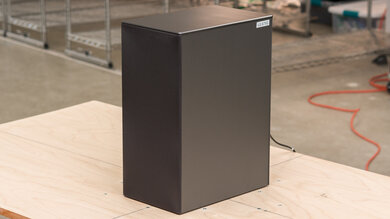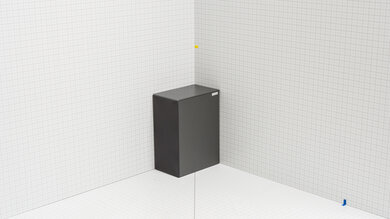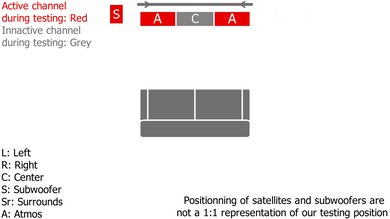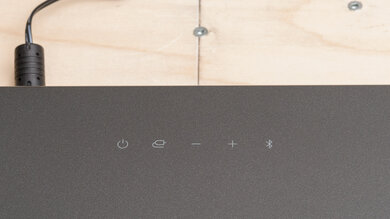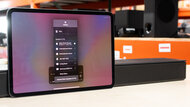The LG S75Q is a 3.1.2 setup released in 2022. It's one of the manufacturer's high-end models for the year with Dolby Atmos support, alongside the LG S80QY and the LG S90QY. It uses built-in Meridian Technology to improve audio reproduction, and you can connect it to compatible LG TVs for TV Sound Mode Share. However, it only has two up-firing Atmos drivers compared to the 3.1.3 S80QY and the 5.1.3 S90QY, and it doesn't offer more premium features like AI Room Calibration to optimize the bar's sound based on your room's acoustics.
Our Verdict
The LG S75Q is decent for mixed usage. It's a pretty versatile bar with Dolby Atmos support, though its height performance is just okay overall. Out-of-the-box, it reproduces pretty clear and accurate dialogue, and its discrete center channel enhances the quality of voices in TV shows. It lacks low bass, though, so you don't feel the rumble in bass-heavy music or action-heavy movies. Surround sound isn't the best, either.
The LG S75Q is good for dialogue-centric content like TV shows. It's a 3.1.2 setup, so it has a discrete center channel that helps reproduce dialogue clearly and accurately. You can use its 'Clear Voice' dialogue enhancement feature if you want, and there's also a Night Mode feature to balance out the volume level when you watch shows at night. Out-of-the-box, its balanced mid-range means voices are clear in the mix, though they're also a bit dark due to the recessed treble.
The LG S75Q is decent for music. Out-of-the-box, it has balanced mids that reproduce clear and accurate voices and lead instruments. There's a little extra boom in the high bass, and its recessed treble adds a slight darkness to the sound. You have lots of customization features on hand, including bass and treble adjustments and EQ presets. It can't reproduce the deep thump and rumble in the low-bass found with bass-heavy music like hip-hop and EDM.
- Bass and treble adjustments.
- EQ presets.
- Lacks low-bass.
The LG S75Q is decent for movies. It supports Dolby Atmos content, which is often found on streaming services. The bar's height performance is decent, but it doesn't provide the same immersive experience as more premium models. There's also support for surround sound like Dolby Digital and DTS, though it has to downmix this content into stereo in order to play it. Its lack of low-bass means that you don't feel the deep rumble in action-packed scenes.
- Bass and treble adjustments.
- Dolby Atmos support.
- Lacks low-bass.
Changelog
- Updated Jun 13, 2024: We've added a comparison between this soundbar and the LG SG10TY in Build Quality.
- Updated Dec 19, 2023: Added market comparison with the Samsung HW-Q600C/Q60CC in the Stereo Frequency Response box.
- Updated Nov 02, 2023: Added market comparison with the LG S77S in the Video Passthrough to TV box.
- Updated Jun 07, 2023: Converted to Test Bench 1.2. Updated the results for audio format support via ARC/eARC, HDMI In, and Optical. Added Video Passthrough to TV results as well.
Check Price
Differences Between Sizes And Variants
The LG S75Q is available in 'Black', and the label for our model is here.
If you come across another version of this soundbar, let us know in the discussions.
Popular Soundbar Comparisons
The LG S75Q is a 3.1.2 setup with Dolby Atmos support. It's a fairly versatile bar, but it's best suited for listening to dialogue-centric content like TV shows and podcasts. It lacks low-bass, and its surround sound isn't that great on its own, especially compared to more premium setups like the LG S90QY.
See also our recommendations for the best soundbars, the best Dolby Atmos soundbars, and the best LG soundbars.
The LG S75Q is better than the LG S65Q. The S75Q is a 3.1.2 setup, and it supports Dolby Atmos content found on lots of streaming platforms, unlike the S65Q. The 3.1 S65Q is still a solid pick for you if you just watch TV shows and music.
The LG S80QY is better than the LG S75Q for most uses. The S80QY comes with more sound enhancement features like room correction and more wireless playback options. It can also reproduce a more extended low bass, so you feel more thump and rumble in your audio. The S75Q also supports Dolby Atmos content and is a more affordable alternative.
The Samsung HW-Q600C/Q60CC and the LG S75Q are both 3.1.2 soundbars, and the Samsung is better overall. The Samsung can reproduce more low-bass, so you feel more rumble in the mix. Plus, it has a better performance on its height channels with Dolby Atmos content. There are some more sound customization tools, like a graphic EQ.
The LG SC9S is better than the LG S75Q. It comes with more features, including a room correction tool to calibrate its sound based on your room's acoustics, Wi-Fi, Chromecast, and Apple AirPlay capabilities. It also has a better stereo soundstage and a better low-frequency extension to bring more thump and rumble to the mix. Plus, there's an additional up-firing center channel designed to improve vocal reproduction in the mix.
Test Results

The LG S75Q is a simple soundbar with a similar design to the LG SP8YA. It's mostly plastic, and there are two metal grilles on top of the bar where the up-firing drivers are located. While the SP8YA has rounded corners, the S75Q's corners are square.
This setup doesn't come with satellites. We purchased the SPQ8-S Rear Speaker Kit separately, but when we tried to connect it to the bar, it didn't work. It doesn't seem to be an issue with the speakers themselves, as they connected to the LG S80QY without issue. If you've tried this setup yourself, we'd love to hear about your experience in the discussion section below.
The LG S75Q has a good build quality and feels more sturdy than the sleek, wall-mountable LG SG10TY. The bar is mostly plastic, which feels solid and durable. The sub is also plastic. There's fabric on the front, and it's tight, so it isn't likely to rip. It can collect dust over time, though.
The LG S75Q has a decent stereo frequency response out-of-the-box. It has a fairly balanced mid-range that reproduces clear vocals and lead instruments. The treble range is slightly recessed, so instruments are pushed towards the back of the mix with certain tracks. It doesn't reproduce a lot of low-bass, either, especially compared to other 3.1.2 Atmos models like the Samsung HW-Q600C/Q60CC, so you don't feel as much thump in bass-heavy music.
With its bass set to '0' and its treble set to '5', the LG S75Q has a satisfactory stereo frequency response. It has a more neutral, balanced sound profile with balanced mid and treble ranges, so voices and lead instruments are clear and detailed. That said, bass adjustment features can't make up for the lack of low-bass, so you still don't feel the rumble in bass-heavy genres like EDM.
The LG S75Q has a decent stereo soundstage. The soundstage is perceived to be a touch wider than the bar, but it doesn't have any tricks to make it seem wider than that. The focus is decent, and sound effects seem to come from a more general area as opposed to an accurate, pinpoint location.
The LG S75Q has a great stereo dynamics performance. The bar gets loud, filling up larger, open living rooms with sound. Updating the bar to firmware version B230411A improved its performance quite a bit, especially regarding compression. There's a bit when the bar is pushed to max volume, but it's not very noticeable.
The LG S75Q has a decent stereo THD performance. At a normal listening volume, distortion falls within good limits, so audio reproduction is clean and pure. There's a jump in distortion at max volume, which audiophiles are more likely to notice. That said, casual listeners who rarely crank up the volume aren't likely to notice any issues.
The LG S75Q has a good center channel performance. With its discrete center channel, dialogue reproduces with clarity and accuracy, and voices are localized to pinpoint locations within the soundstage. Its frequency response on this channel is quite balanced in the mids, so voices are clear, but the dip in the mid-treble means they lack some detail.
The LG S75Q has a poor surrounds performance. It's a 3.1.2 setup, so it has to downmix surround sound into stereo to play it. As a result, it doesn't seem like the action is taking place all around you—it just seems like your movie is playing from a speaker in front of you. The LG S75QR has satellite speakers, offering better performance with surround sound.
The LG S75Q has two up-firing drivers built into the bar to simulate height with Atmos content. The frequency response of these channels is quite uneven, though, especially in the low-mids and the treble. Some details are less clear in the mix as a result. Also, we subjectively evaluated the bar's Atmos performance to get a sense of its overall soundstage and immersive feel. The results were okay, but nothing special. Most of the sound seems like it's coming from the space in front of you, but it doesn't do much to spread the effects to the space around you, which is typical for a bar without satellites. You don't notice a lot of height, either, or sound behind your couch.
The LG S75Q has a satisfactory selection of sound enhancement features. You can customize its sound using features like its bass and treble adjustments or its EQ presets: 'Standard', 'Bass Blast', 'AI Sound Pro', 'Cinema', 'Sports', 'Game', 'Clear Voice', and 'Music'. The 'Cinema' preset doubles as a virtual surround mode that creates a more three-dimensional sound, and the 'Clear Voice' preset enhances dialogue. If you choose to add on rear satellites, you can adjust the rear levels. Most of these features are accessible in the LG Sound Bar app. Unlike the Samsung HW-Q60B, there's no graphic EQ available, though, and you won't find a room correction mode unless you upgrade to the LG S80QY.
Like many other soundbar manufacturers, LG offers a feature that lets you pair the bar with compatible LG TVs - it's called TV Sound Mode Share. Check your TV's Sound Menu to make sure you're in 'Enjoy Soundbar Sound Mode' instead of 'Enjoy TV Sound Mode' to get the feature to work - otherwise, it might downmix higher-quality formats like Dolby Atmos into PCM content. The manufacturer says that this feature enhances the sound quality, but like most of these features, there isn't much of a difference in the sound with it turned on.
You can connect the LG S75Q to your TV over HDMI and Optical connections. It even comes with an HDMI cable, which is handy. Also, the manufacturer says that you can use its WOWCAST device to wirelessly connect the bar to a compatible LG TV. The feature was only available in Europe at the time we tested the bar. You can still plug the bar into your TV using a cable.
The LG S75Q has fantastic audio format support via ARC, and it supports lots of different formats from Dolby Digital surround sound to lossless and object-based formats like Dolby Atmos.
The LG S75Q has fantastic audio format support via Full HDMI In. It supports common surround sound formats like Dolby Digital as well as lossless and object-based formats like Dolby Atmos.
The LG S75Q supports both Dolby Digital and DTS via Optical. Dolby Digital is the most common surround sound format, and it's found on lots of streaming services. DTS is less common on its own, but it's often used as a fallback for higher-quality DTS-HD MA formatted Blu-ray discs.
The LG S75Q has a great latency performance, especially after updating the bar to firmware version B230411A. It has fairly low latency, so the audio you hear is in sync with the video you see. You can use the app's AV Sync feature to reduce lag. Some apps and TVs compensate for latency differently, so your experience can vary.
The LG S75Q can passthrough high-quality bandwidth signals, so when you connect the bar between your TV and your PC, text on the screen is clear and crisp. There's Dolby Vision Passthrough support, too, but unlike with the LG S77S, you can't passthrough 4k @ 120Hz.
The LG S75Q lets you wirelessly stream audio from your mobile devices to the bar via Bluetooth.


